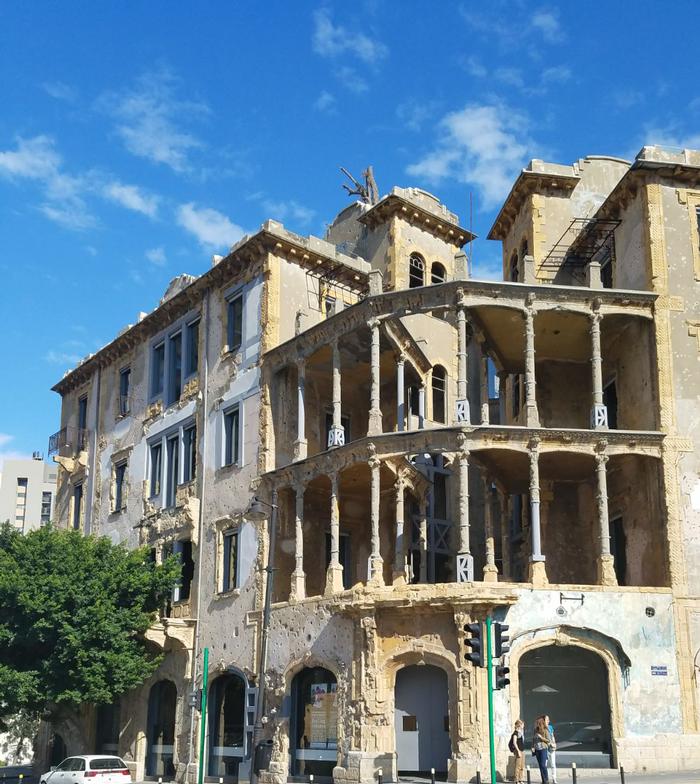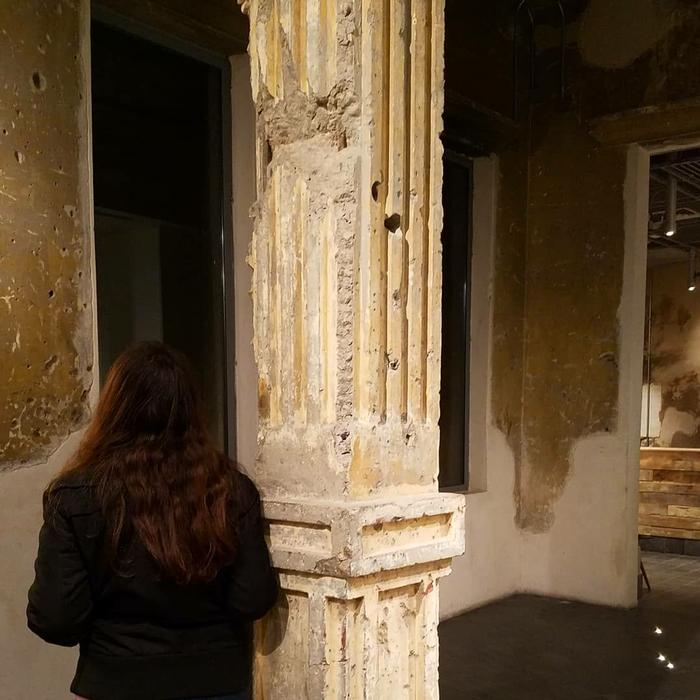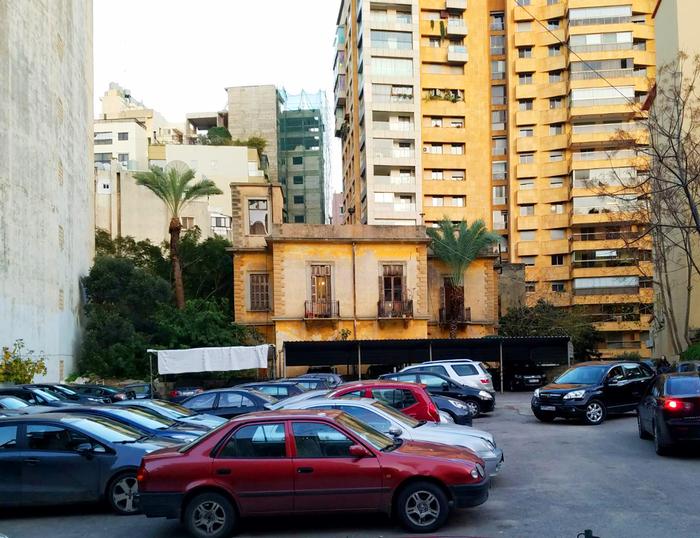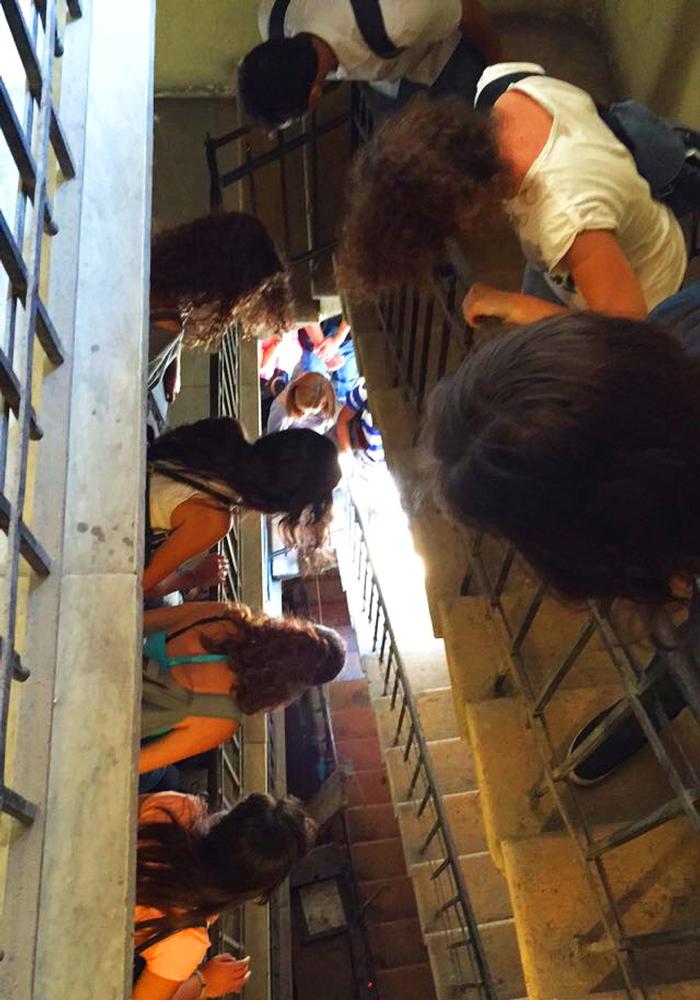Meriam Soltan EssayArchitectural Preservation in Beirut: A Search for the Future in a Past that Refuses to be ForgottenArchitectural Preservation in Beirut: A Search for the Future in a Past that Refuses to be Forgotten “All social change begins with a conversation.”- Margaret Wheatley I hadn’t known what to expect when my family moved to Lebanon in the summer of 2010. My vague recollections about the country were centered around family, a whole lot of it, and wars, of which there were many. In my years here since, I have learned that these recollections can’t, and won’t, be kept separate due to the citizens’ collectively repressed memories of the Lebanese Civil War (1975-1990). The nation and its people are so unwilling to properly acknowledge this history that school textbooks conclude in 1943, the year Lebanon gained its independence. This lack of an official narrative can be attributed to the existence of a variety of sectarian parties and geopolitical factors still at play today that mutually benefit from a buried past and a history that remains dangerously open to interpretation. With no official account of the 15-year tragedy that completely altered the course of this country, its people, and their lives forever, a new generation that did not live through the war are forced to hesitantly navigate the future it has created for them. That future exists within a built heritage that has had history blasted into its very foundations, riddling its walls with the bullets of a past that refuses to be forgotten. These abandoned, dilapidated buildings that families never made it home to are scattered around the city, creating an urban environment that explicitly bears the scars of this war. Regardless of efforts to forget, Beirut itself, which is home to nearly half of Lebanon’s entire population, is therefore a constant reminder and physical link to a repressed past that remains especially present (Chedid 2012). However, the city remains vulnerable to corruption, which is particularly apparent in new developments and master plans that clearly disregard anything of historical significance, which in turn threatens to bury this history once and for all. Movements calling for the preservation and restoration of this built heritage have since been manifested in favor of an urban environment that maintains a firm link to the city’s shared past. At the forefront of these efforts are two notable buildings, Beit Beirut, a former sniper outpost located at the intersection of Independence Avenue and Damascus Street, and a building simply dubbed Mansion located in the historic quarter of Zokak el Blat. The dedication with which activists from across a variety of fields and backgrounds have fought for the preservation of these buildings therefore calls into question the impact such efforts have had on their respective communities and the city at large while also prompting an exploration of their potential influence in promoting new social environments and different ways forward. Of the two buildings in question, Beit Beirut is most explicitly linked to the civil war. However, before being appropriated to facilitate the violence of the war, the building hosted families within its eight spacious apartments across four floors for nearly five decades. Built in 1924 by architect Youssef Afandi Aftimos for the Barakat family, the building was designed with the best of Beirut in mind, with large windows and spacious colonnaded verandas providing views of the entire city (Brones). With the central axis open to city and sky, the avant garde nature of the Barakat Building uniquely emphasized the importance of architecture that links people to each other and their city. It is hard to imagine that an architect’s dedication to the improvement of the human experience could be so violently appropriated to facilitate the exact opposite. The strategic nature of the site and the exceptional architecture that was uniquely designed to provide its inhabitants with panoramic views of Beirut proved invaluable to local militias who converted the Barakat Building into a sniper outpost for the duration of the war (ibid). The building’s location at the Sodeco Crossroads on Beirut’s Damascus Street emphasized its new role in dividing the city, as it was this boulevard that strictly separated Christians from Muslims in East and West Beirut respectively, for nearly 15 years. The formerly spacious, light filled rooms were reconfigured into dim bunkers with walls of sandbags dividing up the space and sectarian graffiti replacing the once extravagant art deco décor. The year is now 2018, nearly three decades after the end of the civil war, and the entire city continues to function along the war map upon which the civil war was fought, with major urban boulevards like Damascus Street still dividing the city decades later. This building still exists within this aftermath only because of the tenacity and dedication of local architect and activist Mona Hallak who, having chanced upon the building one day in September of 1997, was able to prevent its demolition by calling for its preservation and expropriation as a museum by the Municipality of Beirut. Following years of lawsuits and legal proceedings, a permit for its rehabilitation was finally granted in 2003 (ibid). Many more years of fundraising, planning, and design culminated in the restoration and rehabilitation of the building by architect Youssef Haidar. With the awareness that the violent forces that shaped the nature of this building are far stronger than any single, designed intervention, Haidar worked to not only rehabilitate the structural integrity of the building, but also to preserve the physical traces of violence that have become integral to its identity (Abou-Aleiwi). Steel reinforcements brace the severely damaged walls and columns of the building’s iconic atrium, while windows are properly replaced and gaping holes are filled in to protect against the elements. Haidar makes a point of strictly differentiating between original and contemporary work on the building through choice of material in an effort to make clear the varied nature of the building’s history. The building’s eclectic essence and past lives are therefore distinctly preserved through these efforts, with the new additions marking the beginning of its third life. Regardless of the completion of the multi-million dollar rehabilitation project, the municipality continues to frustrate in that a mishandling of authority and a lack of proper planning has left Beit Beirut without any staff or permanent collection (Hallak). Supposedly opened to the public in 2017, the project has since come under fire for functioning more as an extravagant venue in service of the municipality rather than the unprecedented museum of memory it was promised to be. Officials attribute these delays to ongoing debates concerned with the museum’s representation of the civil war. It is in such deliberations that activists like Hallak continue to participate following the physical restoration of Beit Beirut. To her, the stories and scars that the building holds are just as important to preserve as the structure itself. It is for that reason that a more personal means of representation, independent of any specific names or statistics is being promoted for this specific museum. This is largely due to the fact that a search for answers about the war leads to a mess of failed politics and sectarian narratives, with these accounts leading back home to family and friends because it was, after all, a war of our own creation. The Lebanese are therefore in a unique position because their understanding of one of their most important histories is acquired not through formal narratives defined by names and dates, but rather through extremely personal accounts and experiences recounted by family and friends. A contemporary oral tradition has manifested itself across the nation and well beyond its borders into the homes of Lebanese expatriates who themselves are part of a diaspora nearly double that of the 4 million national population. Post-war youth are only made aware of this history through secondhand memories passed down to them at home or over the phone by family nostalgic for a life they never came home to. Their violent history becomes the youths’ contemporary struggle to piece together a historical jigsaw puzzle missing most of its pieces. Activists lead by Hallak are therefore fighting for a Beit Beirut that honors these personal stories, many of which it is at the center of. As a microcosm of the Lebanese struggle, the building itself is far from neutral and is fit to begin weaving together a proper understanding of these narratives. Beit Beirut bears the scars of this war, just as the Lebanese do, and it is home to a history that deserves to be told and demands to be heard. A recognition of these collective experiences fights back against manipulative sectarian narratives that stress on who experienced what to instead highlight that we, ultimately, experienced it together. That is, perhaps, the most important aspect of this entire project. With more than its fair share of setbacks, the project is nowhere near completion, and yet it is already wholeheartedly inspiring a profound change within its society through the dialogue it has prompted across a variety of major fields and social spheres. In questioning the traditional divides that have dictated life in Lebanon for so long now, the project has finally prompted the public to demand of the government the need for public spaces devoted to an official, unbiased understanding of this shared history (Larkin). It is encouraging debate that questions how exactly that is to be done, and it has created a body of activists that recognize the importance of understanding these narratives both personally and collectively (Brones). In a city that has been so aggressively restructured following the end of the war, preservation becomes an act of defiance and restoration, an act of courage. Slowly but surely our past is therefore elucidated through conversations and projects that are taken up by the socially conscious activists born of our neglected built environment. Where Hallak works to create a space that pieces together Beirut’s fragmented past, her contemporaries that have assumed responsibility for Mansion attempt to help youth navigate the circumstances of this present as well as their ways to the future. Located in Zokak el Blat, or “the cobbled alley”, Mansion is one of the last remaining villas that formerly characterized this quarter of Beirut. The cobbled streets have since been paved over, and the stately stone mansions have been replaced by concrete high-rises. This is largely due to aggressive urban development in Zokak el Blat’s northern neighborhood which lies within the boundaries of the controversial Solidere master plan that was responsible for completely restructuring Beirut’s downtown district following the end of the war (Chedid). This master plan, which has been heavily criticized for its destruction of the city’s built heritage, along with the introduction of new major roads such as Fouad Chehab Avenue, have fragmented the once prestigious neighborhood, leaving it vulnerable to investors seeking to profit off of its strategic proximity to the city center (ibid). Efforts made to protect the rich heritage of the neighborhood have diminished over time as developers undermine the historical significance of the area in favor of acquiring prime real estate. A study conducted by APSAD (Association pour la Protection des Sites et Anciennes Demeures) for the Ministry of Culture in 1995 drew an inventory of historically significant buildings within Beirut. Of the 1,019 buildings listed, 94 were located within Zokak el Blat, 46 of which were listed as being of high architectural importance (ibid). Owners who wished to profit off of the valuable land following the hardships of the war prompted subsequent reevaluations of the initial study, which severely diminished the protected buildings to only 26 within Zokak el Blat (ibid). Mansion has therefore defied the odds in surviving so long, and only exists because its owner and other activists saw within it a potential to encourage the existence of a community dedicated to creating a new, different way forward. Architect Ghassan Maasri approached the owner of Mansion with a vision for creating a collaborative space within the city that could foster a community of individuals interested in understanding their city through the arts. Launched as an unprecedented social experiment, this nonprofit collective opened to the public in 2012 and has since proved incredibly successful in bringing together individuals from across a variety of fields and generations (Maasri). A system has been setup in which permanent residents benefit from studio space in exchange for their aid in restoring and maintaining the two-story villa for use by the greater public. In this way, the rehabilitation and restoration of Mansion itself is very much a collaborative effort. Without Beit Beirut’s generous funding, Mansion’s restoration has therefore been quite modest in nature, with frugal interventions of eclectic, repurposed material keeping the space alive. The two spacious central halls on either floor are populated with a mismatch of reclaimed furniture and can be booked for use in a variety of communal workshops and activities, while the surrounding living quarters have since been transformed into a public library and studio space. A terraced outdoor garden is also maintained for those wishing to trade in the traffic congested city for some relaxation among the trees. As a private home that has been transformed into a public space, Mansion is both modest and intimate, therefore naturally encouraging an environment of collaboration among its users. In this way, the project that is Mansion is as much an effort in physical preservation as it is a plan to rehabilitate the public’s ability to both actively create and experience their community and culture. This is especially important in a political environment as turbulent as Lebanon’s, which has often hindered the development and diversification of its culture and the arts. When the arts are promoted within such collaborative environments, tolerance and acceptance are likewise encouraged. These values are integral to the rehabilitation of a nation that has been divided by sectarian powers for decades. Mansion is slowly but surely paving different ways forward for the public, providing opportunities beyond those that have been generated by its contemporary community that is slowly losing itself to the process of gentrification. By recognizing the relevance of our shared history and built heritage in understanding the circumstances of our present, Mansion has evolved from an experiment, into a truly dynamic social hub capable of creating a public conscious of the sociopolitical and economic forces fragmenting their communities. With an awareness of these factors come questions of their legitimacy, and, ultimately, a will to change them. That, to me, is architecture’s greatest quality. In Beirut, the social art of architecture lies within its ability to start the conversations necessary to truly inspire change. Its ability to create space wherein individuals are able to simply question themselves, their society, and their place in it is invaluable to the future of Beirut and its people. It therefore becomes clear that the preservation of Beirut’s built heritage is the recognition of the nation’s shared history. It is the rehabilitation of its people and their shared culture, and it is the promise for a future in which the country has finally come to terms with the tragedies of its past. If “all social change begins with a conversation” (Margaret Wheatley), no one has more to say than these two buildings. With more than two centuries of history between them, they relentlessly remind their communities of their shared past, and encourage different ways forward, independent of the sectarian strife that has plagued the country for so long. They are both models for social change in that they are aware of and address their greater sociopolitical environments through the creation of new space firmly rooted in the city’s built heritage and an understanding of the importance in recognizing the nation’s past. While public spaces, by all means, can exist in many different forms, it is integral for Beirut that they also exist like this, within buildings that provide a constant, physical reminder of the civil war and the subsequent instability it has engendered within our society. With that in mind, I have often wondered how a nation can possibly come to terms with one war, when others are constantly threatening to spill over its borders. But the peoples’ courage to live and experience life in the face of adversity is infectious, and I can’t have helped but be humbled by it every so often since moving to this city. Just as every war has a specific beginning, but no true end, the built environment also continues to shape us, as we shape it. Beit Beirut and Mansion only continue to exist because of the socially conscious body of activists they have created and the conversations these citizens have in turn encouraged in an effort to understand their city, their place in it, and their role in it's future. Works Cited and Works Consulted Abou-Aleiwi, Adam, and Erika Linenfelser. "Post-Trauma Aesthetics," Agora, 2017, pp. 90-100. Brones, Sophie. “The Beit Beirut Project. Heritage Practices and the Barakat Building.” Archives, Museums and Collecting Practises in the Modern Arab World, edited by Sonja Mejcher-Atassi, John Pedro Schwartz, Ashgate, 2012, pp.139-155. Chedid, Rita E., et al. “Urban Observation Zokak El Blat.” University de Balamand- Académie Libanaise des Beaux-Arts, Institute of Urban Planning, 2012, pp. 8–21. Hallak, Mona. Personal Interview. 16 January 2018. Haugbolle, Sune. War and Memory in Lebanon. Cambridge University Press, 2011. Larkin, Craig. Memory and Conflict in Lebanon: Remembering and Forgetting the Past. Routledge, Taylor & Francis Group, 2014. Larkin, Craig. “Remaking Beirut: Contesting Memory, Space, and the Urban Imaginary of Lebanese Youth.” City & Community, Blackwell Publishing Inc, 17 Nov. 2010 Maasri, Ghassan. Personal Interview. 18 January 2018.
Additional Help and InformationAre you in need of assistance? Please email info@berkeleyprize.org. |




